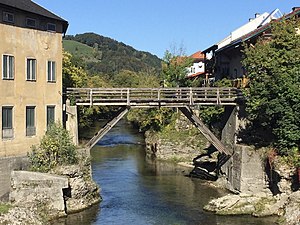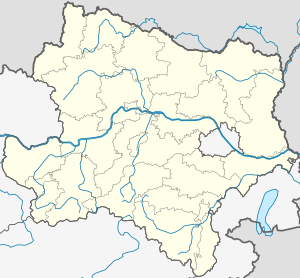Heuberg Bridge (Scheibbs)
Coordinates: 48 ° 0 ′ 57 ″ N , 15 ° 9 ′ 31 ″ E
| Heuberg Bridge | ||
|---|---|---|
| Heubergbrücke from the banks of the Erlauf | ||
| use | Road, bicycle and pedestrian bridges | |
| Crossing of | Erlauf | |
| place | Scheibbs | |
| construction | Double truss - wooden bridge | |
| Number of openings | 1 | |
| start of building | before 1821 | |
| planner | anonymous carpenter, Amstetten | |
| location | ||
|
|
||
The Heubergbrücke in Scheibbs is a wooden bridge over the Erlauf , the construction of which can be dated to before 1821. It is the oldest and only surviving wooden bridge that is not a wooden footbridge, both in Scheibbs and in the entire Scheibbs district . It was originally part of the factory premises of the Wagenachsenfabrik Gaißmayer & Schürhagl and subsequently the clay industry Scheibbs , which was on the left and right of the Erlaufufer. The bridge is a single-lane double truss construction , the crossing of which on the left bank merges into the Erlauf in a passage through a factory building with a gallery. The Scheibbs Ceramics Museum building follows shortly afterwards . The bridge is located downstream of the Heuberg or Brandstattwehr and one kilometer downstream of another historic bridge, the Roman Bridge .
history
There was already an entry in the Franziszeische Cadastre about the Heubergbrücke in 1821 , which means that it existed before that. In 1837 an Amstetten carpenter renewed the bridge at the Heuberghammer at the instigation of Franz Hueber (Huber) . After a carpenter has built this bridge, it can be assumed that it was a wooden bridge. The Heuberghammer is already mentioned as Mühl in Heyberg in 1462 , in 1770 the hammer belonged to Philipp and from 1814 to Gottfried Punzengruber, who set up a scythe hammer in 1828. In 1851 the Heuberghammer was bought by Sebastian Schürhagl from Boding near Frankenfels and in 1864 the company Gaißmayer & Schürhagl was founded.
In the trift files from 1871 to 1901 the hay barn on the bridge is mentioned again and again, but not the bridge itself. Since it was located high above the Erlauf and had no river yoke , it was not a wooden drift obstacle and was therefore not mentioned in the files but it is shown in the 1901 directory.
When the company Gaißmayer & Schürhagl had to shut down its production in 1924, Ludwig Weinbrenner acquired the factory and founded the Scheibbs clay industry . Since the earthenware production was on the right bank of the river and the kiln on the left, one was forced to find a solution to transport the pottery over the bridge. Therefore, a covered conveyor belt was attached to the bridge railing to make the transport of the fragile goods as safe as possible in any weather.
In September 1942, the municipality of Scheibbs applied to the district administrator for permission to build the bridge, but was turned down due to a shortage of materials during the Second World War . In 1943 the renovation was finally approved, the supports repaired and the truss was built from old railroad tracks.
Despite regular repairs, which are common with wooden bridges, the bridge was never significantly changed. It cannot be determined when the construction of the conveyor belt for the Scheibbs clay industry was removed.
literature
Irene M. Weiß: Bridges and footbridges over the great Erlauf. Association Erlauftaler Bildungskreis. Purgstall, 2003.



